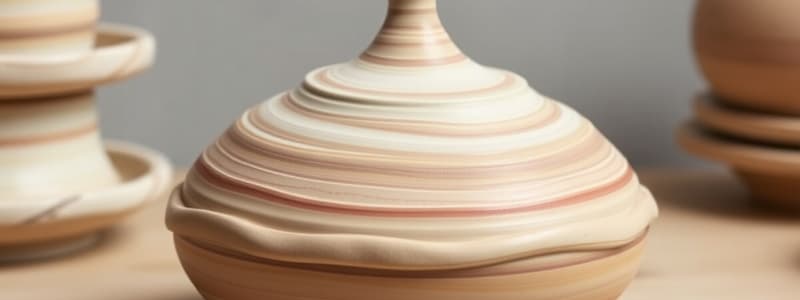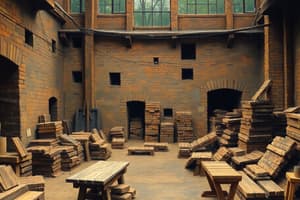Podcast
Questions and Answers
What is the primary purpose of burnishing a pot?
What is the primary purpose of burnishing a pot?
- To join two pieces of clay together
- To add color to the clay
- To polish the surface by rubbing it with a smooth object (correct)
- To create texture on the surface
Sprigs are used in the initial crafting of clay slabs.
Sprigs are used in the initial crafting of clay slabs.
False (B)
What technique involves cutting linear designs into the clay surface?
What technique involves cutting linear designs into the clay surface?
Incising
Glaze creates a _____ effect on a painted surface.
Glaze creates a _____ effect on a painted surface.
Match the decorative techniques with their descriptions:
Match the decorative techniques with their descriptions:
What is the best method to avoid cracking at the joints in a slab construction?
What is the best method to avoid cracking at the joints in a slab construction?
The use of coils is essential for reinforcing corners in slab construction.
The use of coils is essential for reinforcing corners in slab construction.
What is a pointed stick or pencil of colored clay, chalk, or wax commonly referred to as?
What is a pointed stick or pencil of colored clay, chalk, or wax commonly referred to as?
Which type of clay is typically orange to red in color and usually used for pot-plant pots?
Which type of clay is typically orange to red in color and usually used for pot-plant pots?
Porcelain is used mainly for cooking utensils.
Porcelain is used mainly for cooking utensils.
What is the temperature range for firing stoneware?
What is the temperature range for firing stoneware?
The pinch method of pottery starts by rolling out a ball of clay and creating a hole with your ______.
The pinch method of pottery starts by rolling out a ball of clay and creating a hole with your ______.
Match the types of clay with their main characteristics:
Match the types of clay with their main characteristics:
What is the primary purpose of applying a slurry before attaching coils in the coil construction method?
What is the primary purpose of applying a slurry before attaching coils in the coil construction method?
The bust construction method involves creating facial features after the bust is fully assembled.
The bust construction method involves creating facial features after the bust is fully assembled.
Name one common use for earthenware.
Name one common use for earthenware.
What is the primary purpose of using a resist in pottery?
What is the primary purpose of using a resist in pottery?
You should wash clay down the sink after use.
You should wash clay down the sink after use.
What is the initial step in the wheel throwing process?
What is the initial step in the wheel throwing process?
To make a pot, you need to keep the clay __________ during the throwing process.
To make a pot, you need to keep the clay __________ during the throwing process.
Match the process steps in wheel throwing with their descriptions:
Match the process steps in wheel throwing with their descriptions:
How thick should the walls of the pot be when pulling them up?
How thick should the walls of the pot be when pulling them up?
Using a wet sponge instead of sanding dry clay helps to minimize dust.
Using a wet sponge instead of sanding dry clay helps to minimize dust.
A thin layer of glaze is painted or sprayed over the whole work after the __________.
A thin layer of glaze is painted or sprayed over the whole work after the __________.
Flashcards are hidden until you start studying
Study Notes
Types of Clay
- Earthenware: All-purpose clay fired at 700°-1200°C, ideal for decorative ceramics and kitchenware; features vibrant colors due to low firing temperatures.
- Terracotta: Similar to earthenware, fired at 700°-1200°C; characterized by orange to red color, commonly used for plant pots and tiles; requires multiple underglaze coats or a white base for coverage.
- Stoneware: Strong, high-firing clay (1200°-1300°C) that ranges from light brown to grey, typically used for durable kitchenware like casserole dishes.
- Porcelain: Fine-grained, soft, white clay that is fired at 1300°-1400°C; known for strength while being thin, commonly used for delicate tableware.
Construction Methods
- Pinch Construction: Simple method; involves forming a ball of clay, creating a thumb hole, pinching to shape, refining, and smoothing with water.
- Coil Construction: Built by rolling coiled clay; includes creating a base slab, scoring, and slipping connections, while maintaining even coil thickness.
- Bust Construction: Consists of forming two pinch pots for head and torso, creating a coil pot for the chin, and adding facial features, using connection techniques.
- Slab Construction: Involves rolling clay into slabs; requires drying to leather-hard, cutting edges at 45 degrees, scoring and applying slip for connections, and reinforcing corners.
Surface Decoration
- Burnishing: Polishing process using smooth objects or terra sigillata, enhancing surface texture.
- Sprigs: Decorative elements made from press-moulded clay added to leather-hard pieces, created from small moulds.
- Oxides: Colorants that can be mixed with glazes or directly into clay; used to create vibrant designs.
- Incising/Stamping/Rolling:
- Incising: Cutting designs into the clay surface.
- Stamping: Impressing designs into soft clay with carved tools.
- Fluting: Creating grooved designs on pots.
- Inlay: Carving patterns into leather-hard clay and washing away excess for visibility.
- Underglaze: Decorative colors applied before glazing, akin to painting on clay.
- Glaze: Semi-transparent layer applied for color and gloss enhancement.
Other Techniques
- Crayons: Colored clay or wax tools used to draw on bisque or glazed surfaces, with a final glaze layer for protection.
- Resist: Use of wax to prevent glaze adhesion in selected areas.
Wheel Throwing Process
- Preparation: Shape clay into a ball; dampen the wheel surface.
- Centering: Achieve equal weight distribution while coning the clay; crucial for effective shaping.
- Wall Formation: Push down in the center and gradually pull the walls outward to desired thickness.
- Wall Raising: Pinch the rim while pulling upward to form a cylinder shape.
- Shaping: Apply even pressure with a rib tool, expanding the walls of the piece.
- Finishing: Refine wall thickness and smooth the rim; ensure removal of excess clay.
- Cleaning: Post-throwing cleanup and recycling of clay to maintain a tidy workspace.
Occupational Health and Safety (OH&S)
- Ceramic Dust Management: Minimize dust exposure by using wet sponges for sanding; ensure thorough cleanup to prevent dust accumulation.
- Cleaning Practices: Use water to clean tools and workspace; avoid sweeping; do not wash clay down the sink; recycle excess clay effectively.
Studying That Suits You
Use AI to generate personalized quizzes and flashcards to suit your learning preferences.




